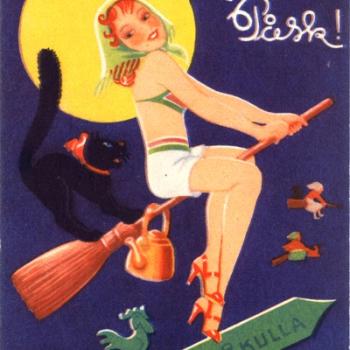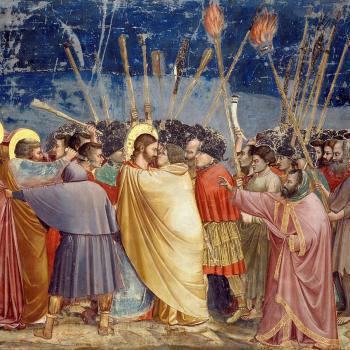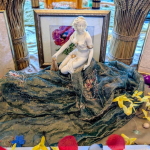The important Celtic feast of Candlemas fell in the middle… (February 2nd). It was held to mark the quickening of the year, and was the first of the four ‘cross-quarter days’ on which British witches celebrated their Sabbaths…
Graves, The White Goddess (p. 163)
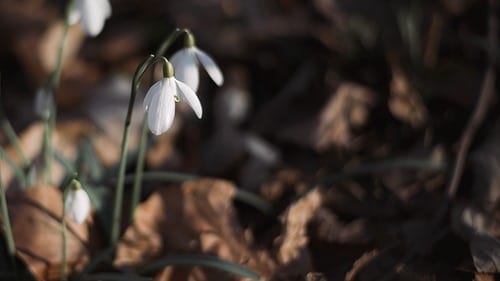
This is the day of Bride,
The queen will come from the mound, I will not touch the queen,
Nor will the queen touch me. (Carmichael, 1992)
Candlemas (Imbolc), February 2, marks the cultural midpoint between the Midwinter solstice and the Vernal Equinox making it, therefore, one of the essential festivals of the cross-quarter days. The pagan and pastoral origins of Candlemas are openly and broadly recognised. As one writer describes, “known as Olmbolc (or Imbolc) in the Celtic Calendar, meaning either ‘in the belly’ or ‘ewe’s milk’, Candlemas was celebrated by rituals that were intended to harness divine energy and ensure a steady supply of food until harvest time some six months hence.” (Morgan, 1893)
Whilst the church acknowledges the Feast of St Brigid, it does little to disguise the pagan and Celtic origins of this fire, healing and fertility Goddess, better known as Bride, Brigid and Briganti (giving Her name to an area and tribe in the North of England) in the Celtic calendar. The custom of the St Brigid’s Cross is testament to the persistence of the folk custom associated with this feminine tradition and these are often seen in and outside of churches to this day.
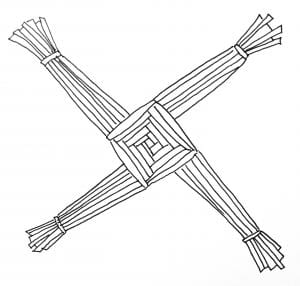
Today is the day of Bride,
The serpent shall come from the hole,
The queen will come from the mound,
I will not molest the serpent,
The serpent will not molest me (Howard, 1995)
In this rendition of a Scottish folk charm recorded my Mike Howard, and identified as being sung upon the morning of the feast of St Brigid or Bride. It is significant that “The queen will come from the mound”, which is indicative of the emerging of the Goddess from the underworld, the Hollow Hill, and the renewal of life upon the earth. The mound is also the long barrow, the grave of the ancestors and entrance to the otherworld, those hollow hills which dot the landscape of Britain and Europe, and to which the race of fairies, sidhe and elves return and make their home.
The cultural landscape which informs our modern tradition and mythology has inherited a wealth of lore pertaining to the ‘rebirth’, or re-emergence, of a Goddess of life (zoe) and returning her gifts to the earth. Pushing through the cold soil, bursting upward from the dark depths with renewed vigour, myths from Ancient Greece and the Levant recognise the Goddess as Kore (Maiden), Persephone (Roman Proserpina), Queen of the Underworld, wife to Hades/Pluto and daughter of Demeter (The Mother), or Roman Ceres (from whence we arrive at the word ‘cereal’ for common grain). Like Inanna or Ishtar, Kore is destined to spend a portion of the year with her husband in the Underworld, rendering the earth barren and cold, while the remainder she shares, like a good daughter, with her mother (The Mother – Demeter) and brings life anew to the land.
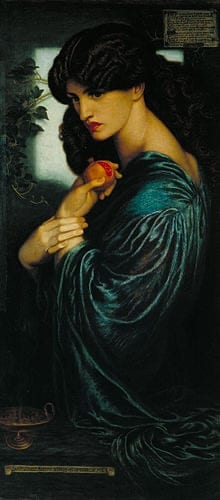
So it is at Candlemas that She emerges from the mound and we ritually observe this time with the lighting of candles, or fires, to draw Her favour for the coming year. Her spirit emerging from the dark earth can already be seen in the green shoots which sprout forth, Her verdant raiments beginning to show, while Her blessed snowdrops symbolise Her awakening upon the earth from its cold, dark lower layer.
The pre-Christian festivities have been carried over by Christianity and it was customary for the church candles to be consecrated at this time. In some parts, people still place lighted candles in the window on this festival to draw the prosperity and fortune of the Maiden as She returns to the land as a moth to a flame.
… five expressing the five stations of her year: Birth, Initiation, Consummation, Repose and Death.
Graves, The White Goddess, (p. 238)
In Robert Graves’ mythology of the five-fold Goddess (Graves: 1999 p.238), this marks the period of ‘Initiation’, when we look at the new beginnings that the year promises and commencement proper of the acts that we hope to bring to fruition in the coming harvest. We must remember at this time that, when we gather in the harvest of our actions this year, we must carefully sow and nurture those things that will guarantee the prosperity of our works. In this, ritual purification is important to ensure that we have prepared the field of our future ready to receive the best possible opportunity to bring our wishes to completion and offer up our works.
The theme of purification, which has found its home in the Christian church celebration of Candlemas, is well observed as the shifting of the Mother aspect at Yule to Her pure and chaste state by Candlemas. The Goddess appears to us as a young maiden, Kore, in the first throes of life, with all its incumbent pangs of love and hope – the growing pains associated with that mindset and awareness that comes with a transition from being reliant to being independent. This is a time, when we can think about our own awareness and mind, our mental attitude and understanding that we might associate with the youthful exuberance not always constrained only to the young. Now is the time to explore that condition and initiate the new, thus instigating the evolution that we carry through from one year and cycle to the next.

The Brigid’s Cross is a symbol of the Goddess that can be made of rushes and placed over the door or hearth. With the association of the Goddess at this time, seen in the correspondences of Brigid, this symbol is believed to protect the house from burning by fire, and it seems appropriate, if you own a fireplace, to place the Brigid’s Cross here in Her honour.
Making a Brigid’s Cross is an easy and pleasing ritual anyone can do and, with each knot made, intention can be woven into the final object making it blessed with the protective thoughts of the maker. What better symbol of Brigid, the Maiden emerging from the darkness of the earth, to place in the centre of your home to bring blessings throughout the year. As a cross formation, the arms point to each of the four winds, while the maze like pattern at the heart suggest the descent and rise from the Underworld which Kore has made at this time. In this way, we can see in the symbolism of the cross pattern the five-fold aspects of the Goddess, as well as the indicative movement as the procession through each round.
Candlemas is a time on intuition, being almost solely of the feminine. Therefore it is fitting that the prayers and dedications should be inspired by the celebrant, and dedicated to Herself. We can decorate with white candles, white cloth and white flowers, especially snowdrops, to remind ourselves that the red of harvest has turned to the pure white of innocence, unmarred by the events yet to come. It is fitting to light a white candle for each of the changes and works you wish to initiate at this time and call the blessing of the Goddess for the prosperity of our actions. Ritually, we will require a small bowl of fresh chilled water, a small quantity of sea salt, a white candle and our forked staff.
For this simple blessing of purification and dedication, we are going to initiate the year and those works of the seasons that we will observe, dedicated to the five-fold Goddess, and reflect upon our own life’s journey. In this way, we initiate ourselves to the round of life, the revolutions of the cycle and evolution of ourselves. Your own rite can be as elaborate or simple as you please, and the following is a suggestion only to prepare the reader. As with all the rites of the year, the symbolism and understanding is more important than the text or rite, and it is through understanding that we may hope to achieve wisdom. Only by engaging can we approach the mystery and hope to gain some comprehension of that which cannot be put into words.
For this, it is best to be outside amongst the new growth of Spring, but you may be inside if necessary. If you are indoors, it would be beneficial to have a large pot or bucket with some earth or soil in. In this pot, or in the earth itself outside, erect the forked stick so that it becomes your altar. Before it, place the bowl of chilled, fresh water and salt, as well as any white flowers you have gathered. If you have fashioned a Brigid’s Cross, you might want to hang this upon your staff.
The actions of the ritual are as simple as its constituent parts and are intended to imbue within them a sense of purification and dedication, and most importantly the theme of initiation, a new beginning. It is important that we think of the Goddess, and how we are ritually enacting her renewal and return to the world. Equally necessary, adjunct to the ritual mythos we are engaging, we are required to meditate upon our relationship with the Goddess and how it evolves, what it means and how it manifests within our lives. This theme is a recurrent one and its relevance cannot be overstated if the festivals are to have any depth of meaning in our lives – if we hope to effectively produce results from the magics we encounter, we must be prepared to act upon the self and work towards that goal. The myths we make covenant with should be relevant to us, but they should also be capable of being fully immersed and they will be fruitful.
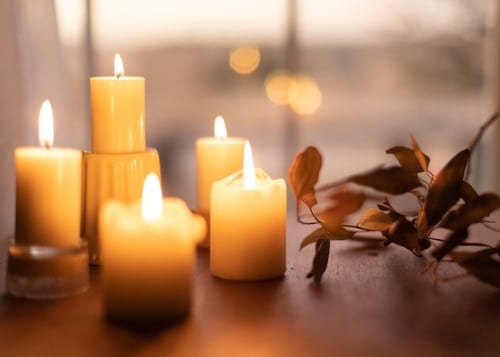
Before the procedure of the rite is given, it is worth considering the theme of initiation. We face many initiations in our lives, and lots of these have been, and still are, marked by rites of passage. In our modern world, so many of these sacred moments have lapsed as the spiritual has lost some of its meaning and relevance to many people in favour of the advances that, nevertheless, render us unconnected. A recent return to the spiritual is admirable, but it must be remarked that this only bears fruit when the connectedness returns us to a condition that has a direct effect upon the individual, as well as community. These often forgotten or neglected rites, given new lease of life through living practice and exchange, however curious or absurd they might first look, provide an undeniable connectivity that puts the self back in harmony with the world and each other, engaging in those forces which inform and out of which we emerge, and will return. In the past, and in some cultures still, rites of passage provide the narrative myth against which life has purpose and meaning, and societies connect and develop a healthy and spiritual life without the sense that vapid media is necessary at all. It is my sincere hope that this marks an initiation that will lead to new and continued initiations, new beginnings upon beginnings that continue to spiral and create a pattern of delight and wonder which can only be found in the mysteries proper. This theme of initiation at this time is paramount, bringing the dedicant to the threshold of the liminal whereby the unknown can become known, only to deposit us back at a place of unknowing.
So, returning to our rite, this can be seen as a new beginning, commencing a life or period that directly involves the mythic within our lives. We dedicate ourselves at this time to the Goddess, called Zoi or Zoe in ancient Greek, meaning life and life-giving. This is the season of life renewed, and it is the prime energy and spirit to supplicate and entreat in order to progress in a healthy and fecund way. We pray at this time for renewal, which is already keenly felt by an innate sensitivity to the seasons possessed by humankind, an awareness of the spirit or genius which enfleshes the world through the tides. How often have you ‘felt’ Spring, or been ‘ready for Summer’ after a prolonged Spring, or noticed the change of the seasons. If you have not paid attention to these sensations and feelings, try to observe them now in that unspoken part of your self.
The Saining of Brigit
This rite appeals to Brigit in the context of initiation and purification, in order to receive blessings upon this occasion. The prayers to Brigit are adapted from the Carmina Gadelica (Carmichael, 1992).
Now it is time to take the sea salt, which represents the work of man and is a necessity of life, and bless it in the name of Kore Zoë as the divine spark of life. Here is a traditional blessing adapted in minor detail from that used in the grimoire known as The Key of Solomon the King (Unknown, 2002):
The blessing of Brigit be upon this Creature of Salt, and let all malignity and hindrance be cast forth hencefrom, and let all good enter herein, for without thee man cannot live, wherefore I bless thee and invoke thee, that thou mayest aid me.
Take the salt and pour it into the water. Next, consecrate the water, again utilising an adapted version of the exorcism found in the grimoire tradition, which was used by cunning men and wise women in the past:
I exorcise thee, O Creature of Water, by She who hath created thee and caused thee to gather together into one place, that thou cast out all the impurities and uncleannesses of the spirits of the world of phantasm so they may cause no harm to befall all who are blessed by thee.
Once done, this Holy water may now be sprinkled upon the forked staff, candle and upon yourself, saying as you do:
Brigit of the mantles,
Brigit of the peat-heap,
Brigit of the twining hair,
Brigit of the augury.
Brigit of the white feet,
Brigit of the calmness,
Brigit of the white palms,
Brigit of the kine.
I shall not be slain,
I shall not be wounded,
I shall not be put in cell,
I shall not be gashed,
I shall not be torn in sunder,
I shall not be despoiled,
I shall not be down-trodden,
I shall not be made naked,
I shall not be rent,
Nor sun shall burn me,
Nor fire shall burn me,
Nor beam shall burn me,
Nor moon shall burn me.
Nor river shall drown me,
Nor brine shall drown me,
Nor flood shall drown me,
Nor water shall drown me,
Nightmare shall not lie on me,
Black-sleep shall not lie on me,
Spell-sleep shall not lie on me,
Luaths-luis’ shall not lie on me.
Finally, light the candle which has been purified and blessed with the Holy water. Now, the Goddess in her pure and chaste aspect, embodied in the white candle which you have ritually blessed, is present with her sacred flame returned to the world, as indeed Her verdant flame returns to the earth. As you meditate upon the flame, you may use the following prayer (Unknown, 2002):
I am under the shielding
of good Brigit each day,
I am under the shielding
of good Brigit each night,
Brigit is my comrade-woman,
Brigit is my maker of song,
Brigit is my helping-woman,
My choicest of women, my woman of guidance,
Each choicest, each dearest, each…… each guidance.
The remainder of the water can be taken to your home and sprinkled in each corner of each room, reciting the saining prayer above, to bless the home.
Bibliography
– Graves, Robert. The White Goddess: A Historical Grammar of Poetic Myth. Faber & Faber.
– Carmichael, Alexander. Carmina Gadelica: Hymns and Incantations from the Gaelic. Floris Books
– Morgan, Owen. The Light on Britannia. Daniel Owen & Co. (Limited)










